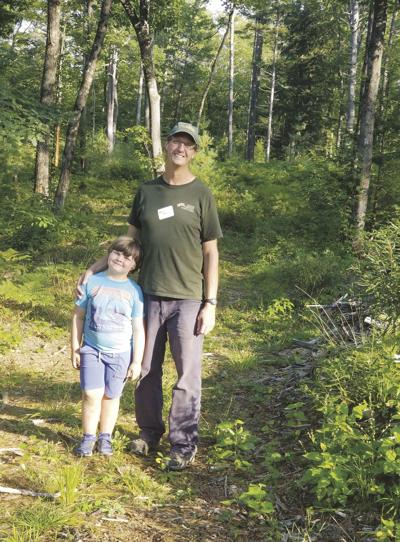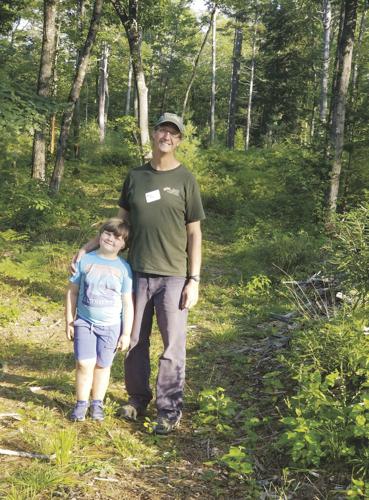BRIDGEWATER — In 2007, Jon Martin, a consulting forester, bought 247 acres in Bridgewater from David Roberts, a landowner with no heirs to inherit his woodlot. Martin paid $200,000 for the parcel, including 35 acres on the Pemigewasset River, and granted a life tenancy on the land, which allowed Roberts to live out his years surrounded by the forest he loved.
When Roberts entered hospice last December, the Martin family brought him to live in their guest room to spend his final days with a window on the woods he called home.
Now Martin, who was New Hampshire Tree Farmer of the Year in 2020, manages this forest for wildlife, recreation, timber and water quality. He and his family use what is now the Martin Family Tree Farm for hiking, walking dogs, cross-country skiing and snowshoeing. His children watch polliwogs in vernal pools and raptors soaring between treetops.
“Open space is the number one reason to do this,” Martin, walking one of the verdant paths he cleared through the property off River Road. “It’s a place to get out and get away from rat race.”
Nationwide, roughly 80,000 certified tree farms contain about 24 million acres of managed woodlands, including 436,000 acres in New Hampshire, the second-most forested state after Maine. Roughly 82% of the Granite State is covered by woods – a total of 4.69 million acres, according to the New Hampshire Timberland Owner’s Association and the U.S. Forest Service.
For New Hampshire it’s been a goldmine. According to 2016 forest industry report shared by the NHTOA, forests contribute $2.8 billion annually to the state’s economy between wood products and recreational uses such as camping, hiking, skiing, snowshoeing, snowmobiling and wildlife watching – making it one of the state’s biggest income generators after health care.
For decades, New Hampshire’s forests have grown by more than they have been harvested. But according to a USDA survey of New Hampshire, the volume of the state’s timber resources started to decrease in 2017 for the first time since the U.S. Forest Service conducted inventories here in 1948. Estimates from the Forest Service in 2020 show that on average, 13,621 acres of forest land are converted to non-forest each year, primarily because of development.
With demographic predictions that the state’s population will grow by 64% over the next 40 years, the future of New Hampshire’s privately-owned forest is uncertain. As aging landowners and forest stewards move away or die, and new owners take control of 1.6 million acres of family forest – the future of this woods is in question. Private holdings account for 72.6% of New Hampshire’s forested land, according to 2020 data from the U.S. Forest Service.
County foresters and consulting foresters like Martin consider their education mission critical. Active management of the woods, whether by becoming a certified tree farm or managing one’s forest for sustainability, is a practice that should be continued.
Foresters now sometimes get calls from newcomers who relocated to New Hampshire during COVID, in search of quality of life and open space. “It’s OK to ask, ‘I bought this property. Now what should I do with it?’” Martin said.
Unmanaged forests are much more susceptible to pests, disease and natural disasters. Management benefits survivability, as well the state’s main natural resource, forestry experts maintain. To the landowner, the payoffs are profits from timber harvests every 10 to 15 years, and ongoing personal enjoyment.
In 1985, Jerry Langdon created an 85-acre tree farm around a driving range on land that he purchased on Route 125 in Epping.
“My main goal was to grow great timber,” Langdon said. “It’s evolved into way more than that. I don’t just harvest trees. My big thing is butterflies and turtles. By doing certain types of harvest, you improve the habitat for them.”
Langdon serves on the board of directors for NH Tree Farm, which gains seven to eight tree farms each year, he said, not only in communities that are stereotypically rural.
“When I bought this, It was a junky, beat up old field,” said Langdon. “I had a stream across my property that used to be a mud hole. Now it runs crystal clear. I have tremendous pine, oak and birch, and clean water. A lot of people like to plant vegetable gardens. I manage a forest. It’s like managing a rose garden.”
“Forested woodlands provide the cleanest water in North America,” said Hunter Carbee, 2020’s NH Forester of the Year, who lives outside Keene.
“Your best wildlife management is a mosaic of cover” including hay fields surrounded by saplings, shrubbery and new growth, and more mature forests. “You want vertical diversity,” Carbee said – vegetation from ground to treetops. With active management of New Hampshire forests, “We’ve seen a lot of improvement in songbirds in the last 10 years,” he said.
Trees also function as air cleaners, capturing carbon that would otherwise remain in the air. Forests serve as filtration systems for reservoirs, preserving water quality, Carbee said.
Ned Therrien of Gilford worked as a forester for roughly four decades, until he sold his 120-acre free farm in Loudon, which surrounds New Hampshire Speedway.
“I spent a lot of time down there,” including watching wildlife congregate at two ponds on the site. “I tried to do the best job I could to make that a better place. I had a lot of joy managing the land.”
Therrien sold to his two neighbors in Canterbury and continues to serve as a consultant. “I’m helping them hopefully learn to be good stewards” with a management plan that includes “prescriptions to make the land grow well in the future.”
To safeguard the forest for future generations, Therrien put on a conservation easement before he sold through Five Rivers Conservation Trust, a non-profit which operates in Merrimack County. The easement now travels as part of the deed, prevents the land from being developed and requires the forest to be managed sustainably whenever it changes hands.
“After 40 years of managing the land, I didn’t want someone to come in and turn it into a bunch of houses, which is happening a lot in New Hampshire,” Therrien said. The new owners, he said, “have the best interest of the land at heart.”
Therrien advises first-time forest owners to contact UNH Cooperative Extension’s county foresters and wildlife biologists affiliated with New Hampshire Fish and Game. “There are a lot of people who have the same dream I did, and there’s a lot of help they can get,” he said.
NH Tree Farm certification is for “folks who believe in stewardship and doing the right thing,” said Tim Fleury, Merrimack County’s forester. The group gathers for education and trading tips. “Contacting your county forester is the first step.”
For more information visit nhtreefarm.org or facebook.com/NHTreeFarm.
County foresters assist landowners free of charge. Landowners can email or call to ask questions or set up a visit. In Belknap County contact Rebecca DiGirolomo, county forester at rebecca.digirolomo@unh.edu or call 603-749-2529. Contact information for residents of other counties can be found at extension.unh.edu/natural-resources/forests-trees.
For a directory of licensed consulting foresters who provide management plans, visit extension.unh.edu/resource/directory-licensed-foresters.
For resources for smaller residential properties, visit extension.unh.edu/agriculture-gardens/yard-garden.



















(0) comments
Welcome to the discussion.
Log In
Keep it Clean. Please avoid obscene, vulgar, lewd, racist or sexually-oriented language.
PLEASE TURN OFF YOUR CAPS LOCK.
Don't Threaten. Threats of harming another person will not be tolerated.
Be Truthful. Don't knowingly lie about anyone or anything.
Be Nice. No racism, sexism or any sort of -ism that is degrading to another person.
Be Proactive. Use the 'Report' link on each comment to let us know of abusive posts.
Share with Us. We'd love to hear eyewitness accounts, the history behind an article.